Subtleties of courtship
Growing ranunculus requires a special attitude towards the plant. To grow a healthy flower, you need to adhere to a certain number of rules.
Flower care:
- Fertilizers should only be used that contain vermicompost.
- It is not recommended to replant the plant, as this may cause its death.
- When buttercups bloom, they require limestone and potassium.
- To extend the flowering time, it is recommended to move the plant into the shade.
- Ranunculus does not tolerate frost, so in winter its tubers should be removed for the winter.
- At the end of the summer season, shoots should be cut off at the root.

Preparing the landing site
It is important to remember that ranunculus flowers do not tolerate low temperatures, so the planting location for them must be chosen taking into account possible drafts and other wind influences. At the same time, the plant blooms better in shady places.
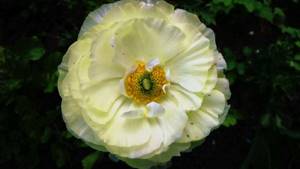
It is recommended to pour sand into the bottom of the planting hole in a small amount.

How does ranunculus reproduce?
For the ranunculus flower, planting and care are not expected to be too complicated. Garden buttercup propagates by both seeds and tubers.
Growing from seeds
Balsam Tom Thumb - growing from seeds at home
It is better to purchase seed material from trusted sellers, otherwise there is a danger of purchasing something that is not what you need. You can also collect from your own ranunculi, but this is a labor-intensive process and it is difficult to achieve a positive result, since the seeds quickly lose their viability.
Note! Storing planting material requires special conditions that an ordinary gardener can rarely provide.
In warm regions, buttercups can be sown directly in open ground. But most often, seedlings are first grown at home, which are then transplanted into a flower bed. The best time for sowing is the end of winter or the very beginning of spring. Before this, the seeds can be soaked in a stimulant solution.
The most suitable substrate is the following mixture: two parts each of leaf and peat soil and 1 part sand. The seeds should be spread on the surface of the soil and sprinkled with a thin layer of soil. Then you need to cover it with film or glass. The best temperature for germination is 11-12 °C.
Important! Every day you need to ventilate the crops, removing the film for half an hour. Condensation that collects on the inner surface must be removed.
After 2-3 days, young ranunculi will appear. Planting in separate pots is carried out in the phase of 4-5 true leaves. Until this moment, the container with the seedlings should be in a well-lit place with a temperature of 20 °C. If there is a lack of sunlight, the plant needs to be illuminated with special lamps. Buttercup does not have any special requirements for capacity.
Seedlings are planted in open ground after the threat of frost has passed, i.e. in the 2nd half of May. Choose a place for planting that is protected from drafts, in the sun or partial shade. The soil should be light, permeable to air and water, neutral or slightly acidic. The minimum distance of planting holes from each other is 15 cm. The seedling is transferred together with a lump of earth or a peat pot.
Note! If planted in waterlogged, heavy soil, the ranunculus root system can quickly rot. To ensure that moisture is easily removed, a thin layer of expanded clay is poured onto the bottom of each planting hole.
Buttercups grown from seeds will bloom in the second year.
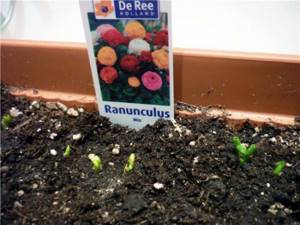
Growing buttercup from seeds
Planting bulbs
Ranunculus are flowers that reproduce well by tubers. For a novice gardener, there are some recommendations on how to plant buttercups with roots.
For planting, rhizomes without signs of disease or pest damage are selected. Just in case, before planting, the tuber is lowered for 30-40 minutes. into a weak solution of potassium permanganate. Then the rhizome is wrapped in a damp natural cloth (preferably gauze) for 2 hours. The dried gauze is changed and the tuber is left wrapped overnight in a cool place. Then the ranunculus tubers are planted in shallow holes (5-7 cm in diameter) with a drainage layer at a distance of 15-20 cm from each other.
Sowing seeds
Let's look at how to plant ranunculus. Buttercup has a rather small germination rate, so it is not easy to grow. The seeds that are collected from the first faded flowers are more likely to sprout. It is best to sow the seeds of the plant in mid-February.

First, the seeds are planted in a container with a substrate. Sowing should be covered with a two-centimeter layer of soil and the container covered with glass or transparent film. The container with seeds is placed in a well-lit place. After two weeks, the first shoots should appear, at which point you need to remove the glass or transparent film from the container.
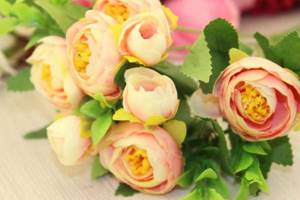
After two pairs of leaves grow, the plants need to be divided into individual pots. After the frosts finally stop, the flowers should be transplanted outside. Having figured out how to plant ranunculi, it’s time to move on to planting tubers.

When and how to plant ranunculus
There are 2 main methods of growing crops - from tubers and seeds. Each of them has certain advantages and disadvantages.
Growing ranunculus from tubers
You can buy ranunculus tubers in late autumn. But it is not recommended to rush into purchasing. It is best to do this in February or March. This is due to the storage conditions of the culture. Tubers require a temperature regime of +15 +18 degrees. Humidity should not exceed 60%.
Expert opinion
Oksana Alexandrovna
A gardener with extensive experience. Vegetable gardening is more than just a hobby for me.
At home, it is not always possible to achieve such parameters. If storage conditions are violated, the tubers lose their viability. As a result, they do not germinate in the required time frame.
Many novice gardeners are interested in how to plant ranunculus tubers. The plant can be grown in seedlings or planted in open soil. In the first case, planting material should be placed in pots at the end of March or beginning of April. The soil must be nutritious and include sand, black soil, and humus. Good drainage in pots is important.
Before planting, the tubers should be placed on a sponge, moistened generously with water. This manipulation lasts 4-5 hours. If you have doubts about the quality of the tubers, you should soak them in a solution of potassium permanganate. A growth stimulator is also great.
When planting tubers in the soil, they should also be soaked in a growth stimulator or potassium permanganate. To successfully grow ranunculus, planting should be done in mid-May. It is best to choose a warm place for the flower. It should be well lit. Wind protection is also important.

Soaking ranunculus tubers in a growth stimulator
It is recommended to deepen each bulb 5-8 cm into the ground. In this case, the sharp end should be directed downward. The interval between the bulbs should be at least 10 cm. This is due to the rapid and active growth of the root system.

If the air temperature drops significantly or frost returns, young plantings should be covered with a layer of straw or other material. In this case, the use of film is prohibited.
Growing ranunculus from seeds
Growing ranunculus from seeds is quite difficult. This process is considered quite lengthy and does not always give good results. It is recommended to collect seeds in summer from faded crops or buy them in specialized stores.
The rate of emergence of sprouts varies among plants. The most viable plants emerge first. It is worth considering that ranunculus has very small seeds that easily fall off. Therefore, to collect planting material, it is recommended to wrap the buds in gauze and shake them a little.
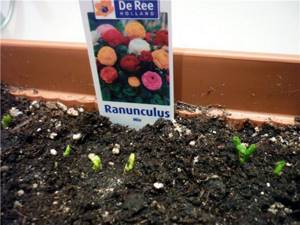
Growing ranunculus from seeds
To grow seedlings, it is recommended to plant seeds in January. It should be buried 2 cm. For this you can use ordinary peat soil. Until the sprouts appear, the containers should be covered with glass. This will help create the necessary greenhouse conditions.
The temperature should be +15+17 degrees. The soil should be systematically moistened. It is recommended to do this using a spray bottle.
Ranunculus seeds do not have a very high germination rate. Even small temperature fluctuations or excessive moisture of the substrate negatively affect the viability of planting material.
When tender sprouts appear, you must immediately install a phytolamp. It will provide young shoots with sufficient lighting. Water the plants sparingly. It is not recommended to do this more than once a week.
Bushes should be picked in April. It is recommended to plant ranunculus in prepared beds in advance. At the same time, it is worth placing pebbles or coals at the bottom of the planting holes, which will provide high-quality drainage and protect the crop from stagnant moisture. When cold weather sets in, plantings should be covered with straw. Non-woven material is also suitable for this purpose.
How to plant tubers
In the spring, when the weather stabilizes and the ground is warm enough, it’s time to plant flower tubers in open areas. This is usually done at the end of April or beginning of May. Before planting, the tubers need to be kept for several hours in sawdust or on a damp sponge.

The tuber is lowered 8 cm into the planting hole. A distance of 15 cm should be left between the seedlings. If the air temperature drops, the planting should be covered with straw. After three months, flower stalks should grow, and a little later the plant begins to bloom.
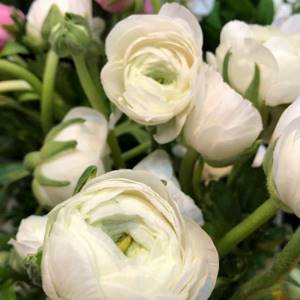
Growing ranunculus from seeds

Ranunculus seeds photo
Seed propagation is a more labor-intensive process. The seeds have an average germination rate. They can be purchased at a flower shop or collected yourself. Collect from the buds that bloomed first. When they bloom, wrap the corolla with gauze so that the ripened seeds do not scatter on the ground. Carefully pour them onto paper, dry, and store until spring.
In mid-February, sow Asian buttercup seedlings. Fill the container with light fertile soil, scatter the seeds over the surface of the soil, sprinkle with a layer of soil 1.5-2 cm thick. Cover the crops with film or glass, place the container with the crops in a lighted place, maintain the air temperature within 15-17º C.
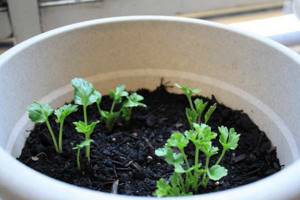
Ranunculus from seeds 16 days after planting photo
Ventilate the greenhouse and moisten the soil. Shoots will appear in a couple of weeks - remove the cover. When a couple of leaves appear, place the young plants in separate containers. After warm weather sets in, plant in open ground. Flowering will occur next year.
Garden care
Despite the capriciousness of the flower, it is not difficult to care for. Systematic watering in moderate quantities is recommended. Buds that have bloomed should be removed immediately. Be sure to regularly loosen the soil around the plant and apply organic fertilizers.

If pests are found on the leaves of a flower, you must immediately treat it with special means. Nowadays they are not difficult to find.
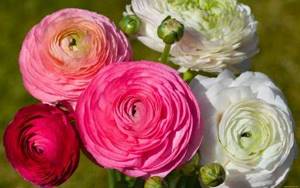
Care at home
When growing buttercups on the balcony, it is advisable to plant several bushes in one pot. Before planting the tubers, they should be soaked in water for 24 hours. At the bottom of the pot, be sure to install a material that absorbs moisture well.
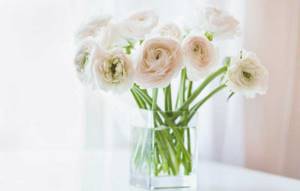
Next, soil is poured and the tubers are buried in such a way that a small part of them remains on the surface. Otherwise, caring for the plant is the same as in the garden.
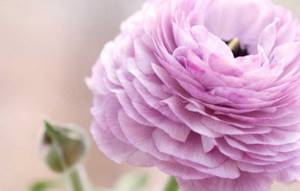
Ranunculus ranunculus in garden and interior design
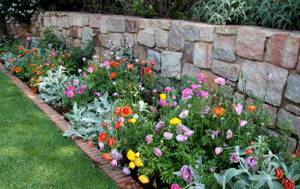
Ranunculus in landscape design photo
The flower can be grown in gardens and indoors; cut peduncles remain pleasing in a vase for about 2 weeks. Ranunculus are often used in wedding bouquets.
The combination of different colors will be a wonderful decoration for flower beds. Decorate borders with bright buttercups.
Home care
When ranunculus blooms, it is advisable to maintain a temperature of 18 degrees at its location. The plant needs direct sunlight, for this it is better to plant it on a balcony or window on the south side.

It is important to remember about systematic watering with a small amount of water and fertilizing with fertilizers, the main thing is to prevent the soil from becoming waterlogged.

Care after flowering in the garden
The best time to dig up tubers in the garden is in the fall. Dried leaves and shoots should be cut off. The root system of the flower is very fragile, so you need to dig it out with caution.

The tubers should be stored at a temperature of 4-6 degrees Celsius, wrapped in dry moss. Before removing the tubers for the winter, you need to treat them in foundation and let them dry for three days.
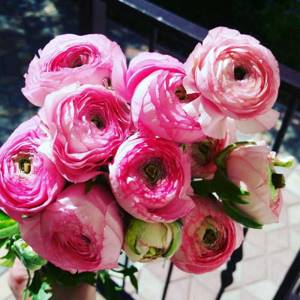
Preparing ranunculus for winter
With the onset of autumn, the tubers need to be dug up. Do this as soon as the leaves turn yellow and dry out. Cut off the stems. Be very careful with the tubers - they are fragile and can break if handled carelessly. Dug up tubers about 30 min. keep in the foundation solution, then dry for 3 days in a shaded place. Wrap the nodules in a paper bag or dry moss and store until spring in a cool room (temperature 4-6º C) with good ventilation.
If in your region the air temperature in winter does not drop below -7º C, ranunculus tubers can be left to overwinter in open ground, but be sure to cover them with leaves or spruce branches.
Care after flowering at home
After flowering, be sure to move the plant to a cool and dark place. The ranunculus will continue to grow for some time, after which dormancy will begin, during which the leaves will become dry and yellow.

The flower's dormancy lasts about a month, then small shoots begin to appear again. It is important to know that each next generation from one flower is weaker than the previous one.











